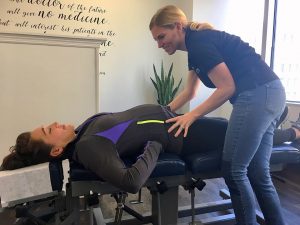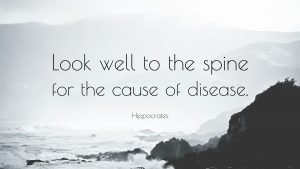Finding a good chiropractor isn’t only key to correcting the damage caused by years of poor posture and/or trauma — it’s also important for everyone wanting to take a proactive approach to his or her health care.
Here is some of the medical research and studies proving the therapeutic benefits of chiropractic.


1. Sciatica
The European Spine Journal published the findings from a clinical trial last year uncovering how chiropractic adjustments resulted in a 72 percent success rate in treating sciatica and related symptoms compared to the 20 percent success from physical therapy and 50 percent from corticosteroid injections.
Compared to most medical treatments, few interventions can initiate back pain relief and healing like chiropractic adjustments can!
2. Low Back Pain and Neck Pain
In a study published in the British Medical Journal 2003, 183 patients with neck pain were randomly allocated to manual therapy (spinal mobilization), physiotherapy (mainly exercise) or general practitioner care (counseling, education and drugs) in a 52-week study.
The clinical outcome measures showed that chiropractic adjustments resulted in faster recovery than physiotherapy and general practitioner care. Moreover, total costs of the chiropractic-treated patients were about one-third of the costs of physiotherapy or general practitioner care.
Another study published in the Journal of Manipulative and Physiological Therapeutics found patients with chronic low-back pain treated by chiropractors showed greater improvement and satisfaction at one month than patients treated by family physicians. Satisfaction scores were higher for chiropractic patients.
A higher proportion of chiropractic patients (56 percent vs. 13 percent) reported that their low-back pain was better or much better, whereas nearly one-third of medical patients reported their low-back pain was worse or much worse.
In a study funded by NIH’s National Center for Complementary and Alternative Medicine to test the effectiveness of different approaches for treating neck pain, 272 participants were divided into three groups that received either spinal manipulative therapy from a doctor of chiropractic (DC), pain medication (over-the-counter pain relievers, narcotics and muscle relaxants) or exercise recommendations.
After 12 weeks, about 57 percent of those who met with DCs and 48 percent who exercised reported at least a 75 percent reduction in pain, compared to 33 percent of the people in the medication group. After one year, approximately 53 percent of the drug-free groups continued to report at least a 75 percent reduction in pain, compared to just 38 percent pain reduction among those who took medication.
3. Headaches (Tension and Migraine)
Second only to back pain, headaches are one of the most common conditions regularly managed by chiropractors.
A group trial found that 22 percent of people who had chiropractic treatment saw the number of attacks drop by 90 percent. In that same study, 49 percent said they had a significant reduction in pain intensity.
Compared to most medical treatments, few interventions can initiate headache relief like chiropractic adjustments can!
4. Colic and Ear Infections
A 2012 study published in Journal of Manipulative Physiological Therapeutics found that chiropractic adjustments greatly reduced colic symptoms.
Although very few randomized control trials have been conducted describing the clinical effects of chiropractic care on children, literally scores of case studies have been documented that describe how children suffering from otitis media (ear infections), acid reflux and colic have experienced complete to near complete resolution after just a few visits.
The reasons for this vary, but one common theme is that nerves controlling the gut and brain are intricately connected to each other and are quite sensitive to neurological insult caused by vertebral subluxations.
5. Neurological Conditions
Exciting research is currently being conducted via upright MRI showing how upper cervical adjustments affect various brain-based conditions. What we have seen so far is quite remarkable.
Not only are MRI scans revealing that cerebral spinal fluid and blood flow are markedly increased after a chiropractic adjustment, researchers are observing that cerebellar invagination (when the cerebellum drops down below the skull line) is being reversed and brain plaquing (common in multiple sclerosis patients) is disappearing!
6. Blood Pressure
In 2007, George Bakris, the world expert on hypertension, published a study with a team of researchers in the Human Journal of Hypertension proving that one upper cervical chiropractic adjustment had the same effect as two blood pressure-lowering drugs. Even more fascinating, the effects of just one adjustment lasted more than six months!
Compared to the placebo-treated patients, those who got the real procedure saw an average 14 mm Hg greater drop in systolic blood pressure (the top number in a blood pressure count) and an average 8 mm Hg greater drop in diastolic blood pressure (the bottom blood pressure number).
Other studies have shown similar findings with hypotensive patients, and their low blood pressure was raised to normal levels after chiropractic care. This is exciting because it highlights the body’s ability to create a homeostatic balanced environment once vertebral subluxations are removed.
7. Surgery Prevention
Chiropractic has long been heralded by natural health care providers as a natural method to prevent back surgery.
In fact, the Journal of the American Medical Association just recently published its low back pain guidelines and suggested that people suffering from back pain first try chiropractic before resorting to surgery.
8. Frozen Shoulder
Last year a clinical trial was published describing how patients suffering from the debilitating condition frozen shoulder responded to chiropractic care.
Of the 50 patients: 16 resolved completely; 25 showed 75 percent to 90 percent improvement; eight showed 50 percent to 75 percent improvement; and one showed 0 percent to 50 percent improvement.
9. Scoliosis
Chiropractic adjustments for scoliosis coupled with muscular rehabilitation techniques may help prevent the progression of scoliosis. Organizations like the nonprofit Clear Institute founded by Dr. Dennis Woggon have set out to empower health care professionals with an effective chiropractic system to treat people with scoliosis.
They’ve perfected a model and discovered that it is possible to effectively treat the condition without the use of restrictive braces or dangerous surgeries. In many case studies, participants have seen a 10 percent to 30 percent decrease in their scoliosis curvatures.
10. Athletic Performance
There is a reason why athletes both today and in the past, like Michael Phelps, Jerry Rice and Joe Montana, are under regular chiropractic care. In fact, over 50 percent of NFL teams have a chiropractor on staff.
Because it is so effective at pain-based and pathological conditions, one of the most overlooked aspects of chiropractic care is that it enhances personal and athletic performance. Studies have sown that it:
Reduces inflammatory cytokines
Boosts your immune system
Enhances pulmonary function
Decreases mental and oxidative stress
Relieves muscle tension
Naturally increases your energy level
Studies have even proved, objectively and subjectively, that chiropractic patients experience “overall increased bodily function,” which includes bowl regularity and mental clarity.
Basically, because it helps place your body in the position where it can heal itself, chiropractic adjustments can free your immune system up to focus on keeping you healthy, which enhances your ability to think, move and perform.
Have you been checked by a Chiropractor? Call our office @ 727-498-5643 !
Reference: https://draxe.com/10-researched-benefits-chiropractic-adjustments/

























